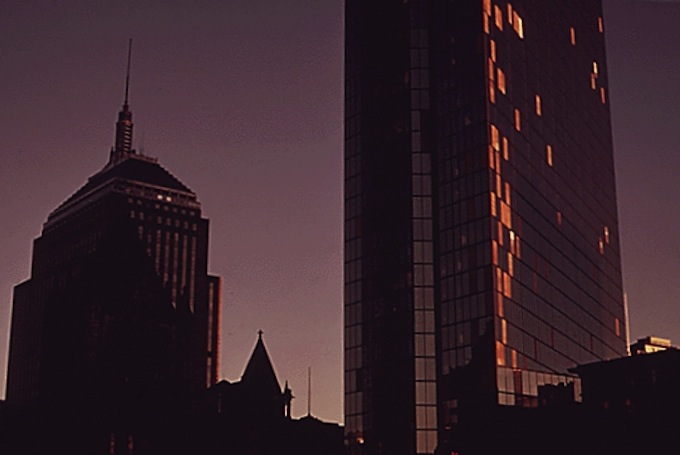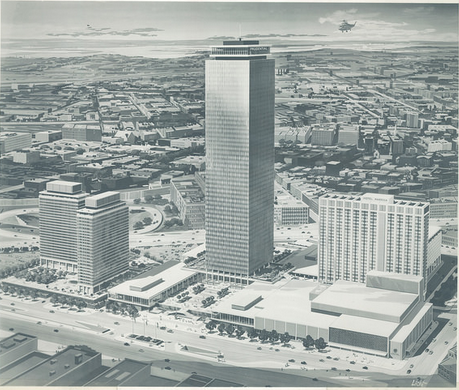
The renaming of Boston’s tallest building from the John Hancock Tower to 200 Clarendon has struck an intriguing chord with me. Increasingly a student of Boston’s urban design and history, I thought that despite insurance giant John Hancock Financial’s removal from the premises – hence the name change – the moniker ought to remain permanent. After all, Bostonians are used to referring to the 60-story structure as The Hancock colloquially.
I couldn’t help but find parallels between the the conception of the building itself with the conception of the city in which it lies. To me, keeping its name is more than just branding. It’s a reflection of Boston’s, and the country’s, ability to adapt, overcome and persevere. And let’s not fool ourselves into thinking the name John Hancock is representative only of the building’s flagship tenant.
When I think of the formerly named John Hancock Tower, the tallest not just in Boston but all of New England, I think of the indisputable manner in which founding father John Hancock himself penned his name at the bottom-center of the Declaration of Independence.
Not only a delegate from Massachusetts in the Continental Congress that adopted and proudly proclaimed the Declaration, it was John Hancock, a successful who inherited the lion’s share of his wealth and prestige from his controversial uncle Thomas, who served as President of the gathering.
Hancock would also serve as the first and third Governor of Massachusetts upon its separation from the British crown.

It’s important to remember that the early years of the American Republic, and Commonwealth of Massachusetts, were iterated upon much as Boston does so successfully in various sectors and industries today.
The United States went from using the Articles of Confederation as its governing document to the Constitution. It endured minor revolts like Shay’s and the Whiskey Rebellion, observed numerous precedents set by inaugural President George Washington and has enacted laws, upheld treaties and shifted power between branches of government.
The early years of the John Hancock Tower witnessed several such evolutions that would eventually lead to the building’s architectural icon status. Today it overlooks Boston and beyond, reflecting the clouds and sky to the point where at certain times and angles it appears almost invisible.
It’s sleek, it’s glossy and it’s known to almost all as simply The Hancock.
But lest we forget, upon its completion the building was something of a disaster.
According to TIME magazine in 1973:
The John Hancock Mutual Life Insurance Co.’s $95 million headquarters in Boston may be the most famous new building in the U.S.—and all because of its window pains. The 60-story tower is supposed to be sheathed with 10,344 windows of a double-paned insulating glass that reflect the Copley Square surroundings. Trouble is, about 3,500 of those windows have cracked, and some of them have even fallen off the building, delaying occupancy for months.
It was later determined that the tower’s windows kept cracking and falling because of “wind oscillations and thermal stress cycles caused by the expansion and contraction of the air between the two glass lights of the panels.”
Further, “the lead connection around the panel’s edge had developed fatigue because the bond obtained by the melted lead solder between the reflective coating and outside light, as well as that between the reflective coating and the lead sealer, was so strong that it did not yield and transmitted the motions to the outer light, cracking it first.”
Eventually all the panels, totaling more than 10,000 many of which were simply boarded up as a temporary solution, were replaced.
William LeMessurier, founder of an engineering and architectural consulting firm, stated “Any time you depart from established practice, make ten times the effort, ten times the investigations. Especially on a very large scale projects.”
Such is an easy phrase to utter in hindsight. Such would’ve been advantageous advice for our founding fathers.
Our founders, though, didn’t simply roll over when it seemed at times the young nation was to be split asunder. Neither did the designers and architects of the John Hancock Tower.

The construction of the tower also constitutes a turning point in general Boston development. Completed in 1976 (the U.S. Bicentennial, by the way), the John Hancock Tower was something of the poster child for urban renewal in Boston. Though it was the Prudential Tower which was truly born out of urban renewal, the John Hancock Tower in retrospect was the icing on the cake standing seemingly hand-in-hand with the Pru overlooking all corners of the Hub.
It was representative of Boston’s step toward a more modern era, one that included the wide sweeping revitalization of various cores within the city’s distinctive communities including some mainstays that we currently enjoy while walking down the street.
In 2011 the John Hancock Tower was recognized by The American Institute of Architects as a Twenty-Five Year Award winner for “architectural design of enduring significance.”
Prior, in 1983, architect I.M. Pei was awarded the Harleston Parker Medal from the Boston Society of Architects which honors “the single most beautiful building or other structure” in Greater Boston.
Boston Properties owns 200 Clarendon, née John Hancock Tower. Though keeping the building known officially as some variant of Hancock may not be the most lucrative or most desirable label to attract tenants (though it has to be more attractive than 200 Clarendon) it may help to reinforce and maintain the deeper significance of what the tower truly means to Boston.
Perhaps this headline from Curbed Boston says it best: Forgotten the New Name of the Hancock Already? Be Honest

